外研版(2019)选择性必修 第二册Unit 4 Breaking boundaries Writing & presenting ideas课件(共18张PPT)
文档属性
| 名称 | 外研版(2019)选择性必修 第二册Unit 4 Breaking boundaries Writing & presenting ideas课件(共18张PPT) | 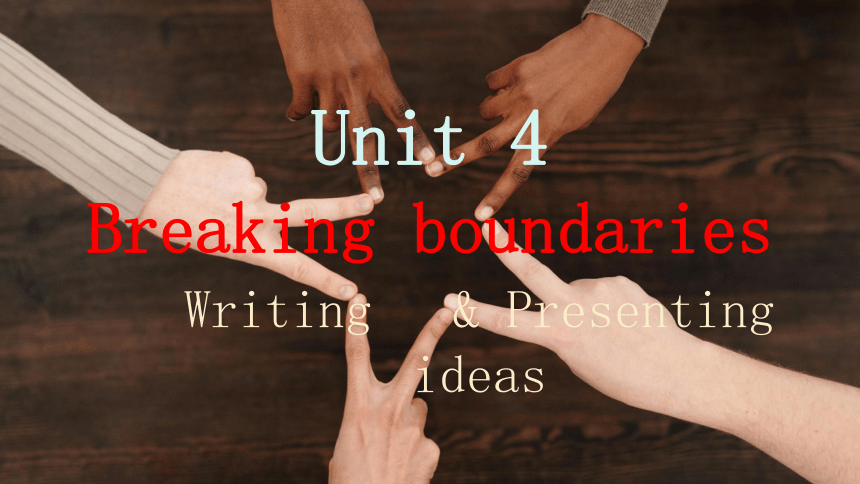 | |
| 格式 | pptx | ||
| 文件大小 | 2.2MB | ||
| 资源类型 | 教案 | ||
| 版本资源 | 外研版(2019) | ||
| 科目 | 英语 | ||
| 更新时间 | 2024-04-23 09:52:06 | ||
图片预览

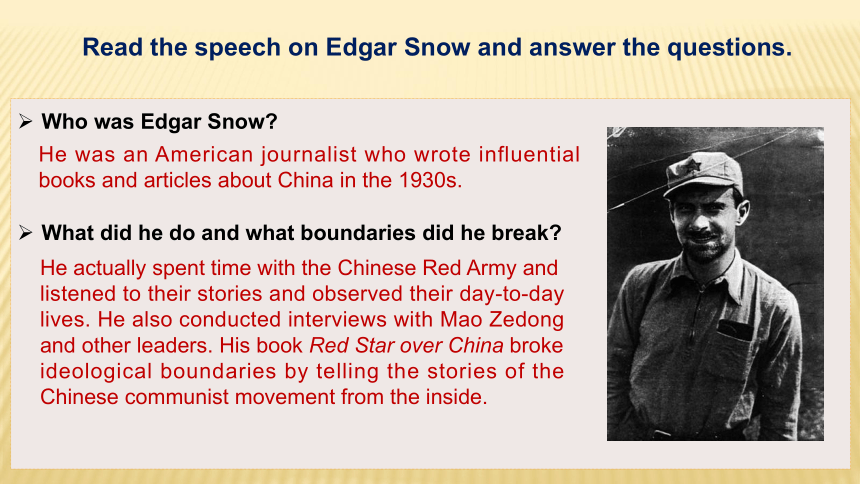
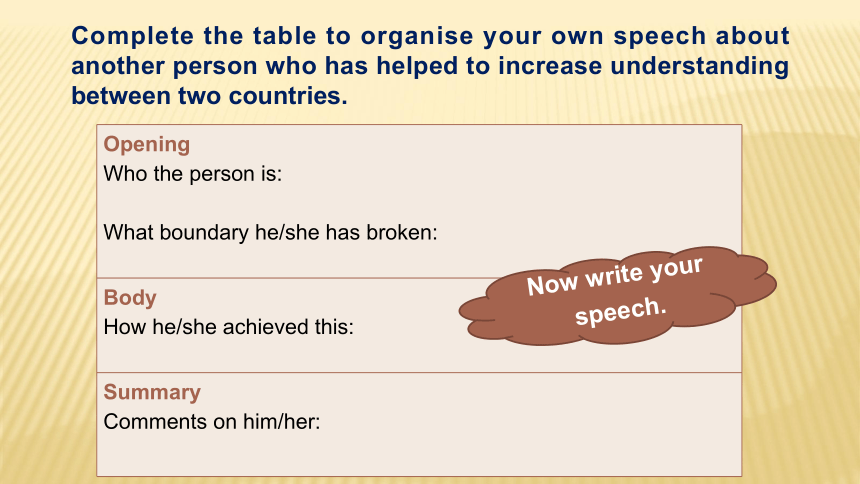
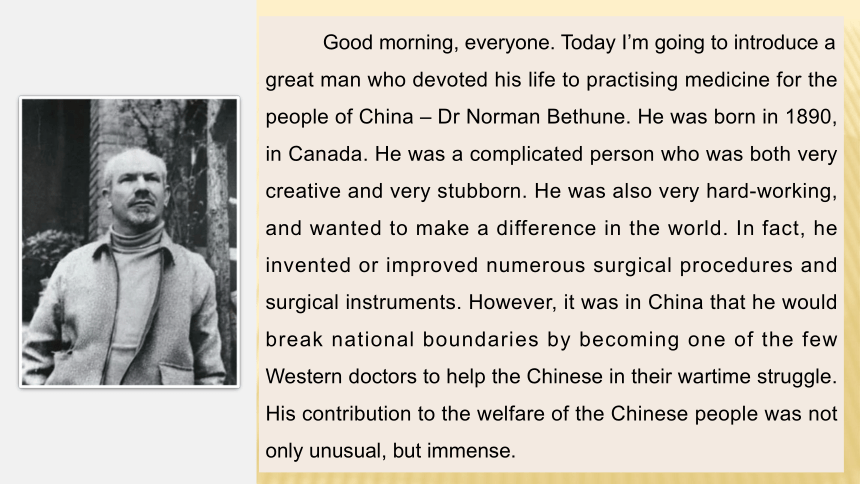
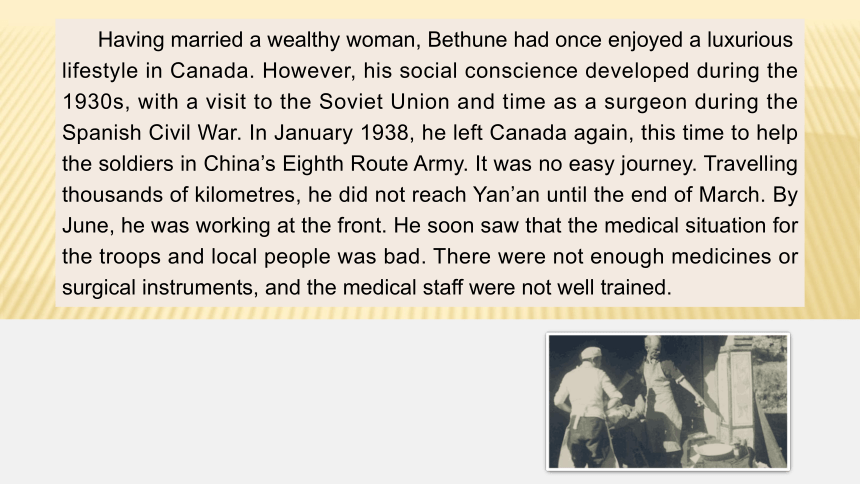
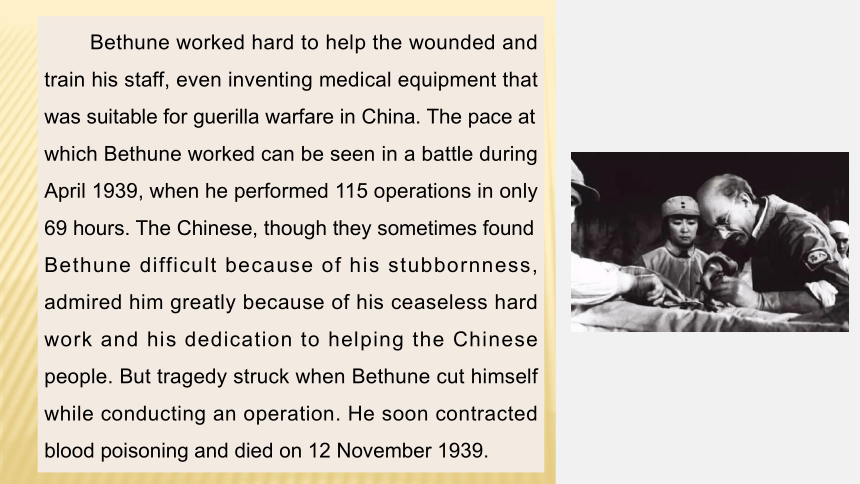
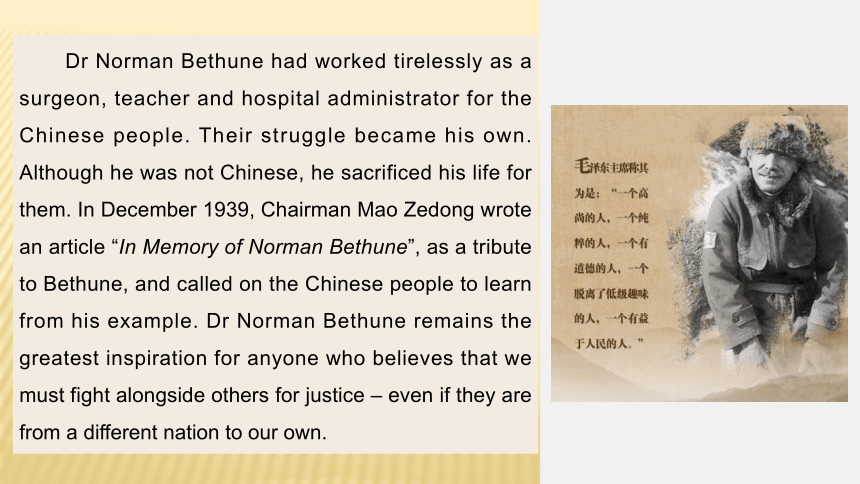
文档简介
(共18张PPT)
Unit 4
Breaking boundaries
Writing & Presenting ideas
Read the speech on Edgar Snow and answer the questions.
Who was Edgar Snow
What did he do and what boundaries did he break
He was an American journalist who wrote influential books and articles about China in the 1930s.
He actually spent time with the Chinese Red Army and listened to their stories and observed their day-to-day lives. He also conducted interviews with Mao Zedong and other leaders. His book Red Star over China broke ideological boundaries by telling the stories of the Chinese communist movement from the inside.
Complete the table to organise your own speech about another person who has helped to increase understanding between two countries.
Opening
Who the person is:
What boundary he/she has broken:
Body
How he/she achieved this:
Summary
Comments on him/her:
Now write your speech.
Good morning, everyone. Today I’m going to introduce a great man who devoted his life to practising medicine for the people of China – Dr Norman Bethune. He was born in 1890, in Canada. He was a complicated person who was both very creative and very stubborn. He was also very hard-working, and wanted to make a difference in the world. In fact, he invented or improved numerous surgical procedures and surgical instruments. However, it was in China that he would break national boundaries by becoming one of the few Western doctors to help the Chinese in their wartime struggle. His contribution to the welfare of the Chinese people was not only unusual, but immense.
Having married a wealthy woman, Bethune had once enjoyed a luxurious lifestyle in Canada. However, his social conscience developed during the 1930s, with a visit to the Soviet Union and time as a surgeon during the Spanish Civil War. In January 1938, he left Canada again, this time to help the soldiers in China’s Eighth Route Army. It was no easy journey. Travelling thousands of kilometres, he did not reach Yan’an until the end of March. By June, he was working at the front. He soon saw that the medical situation for the troops and local people was bad. There were not enough medicines or surgical instruments, and the medical staff were not well trained.
Bethune worked hard to help the wounded and train his staff, even inventing medical equipment that was suitable for guerilla warfare in China. The pace at which Bethune worked can be seen in a battle during April 1939, when he performed 115 operations in only 69 hours. The Chinese, though they sometimes found Bethune difficult because of his stubbornness, admired him greatly because of his ceaseless hard work and his dedication to helping the Chinese people. But tragedy struck when Bethune cut himself while conducting an operation. He soon contracted blood poisoning and died on 12 November 1939.
Dr Norman Bethune had worked tirelessly as a surgeon, teacher and hospital administrator for the Chinese people. Their struggle became his own. Although he was not Chinese, he sacrificed his life for them. In December 1939, Chairman Mao Zedong wrote an article “In Memory of Norman Bethune”, as a tribute to Bethune, and called on the Chinese people to learn from his example. Dr Norman Bethune remains the greatest inspiration for anyone who believes that we must fight alongside others for justice – even if they are from a different nation to our own.
Presenting ideas
1 Work in groups. Look at the pictures
and make a list of boundaries in society.
Boundaries in society:
————————————————————————————————————————————————————————————————————————————————————————————————————————————————————————————————————————————————————————————————————————
Presenting ideas
2 Choose one of the boundaries you have listed and talk about how to break that boundary by answering the questions.
·What led to the boundary
· Who is affected by the boundary
·What can be done to remove the boundary
·How would society change if the boundary were removed
Presenting ideas
3 Prepare a short presentation.
Consider the following:
1) the structure of your presentation
2) useful words, expressions and
Structures
Give your presentation to the class.
Reflection
Write a reflection after completing this unit. Consider the following:
1 What is your understanding of breaking boundaries
2 What text types have you learnt about What are their features
3 What words, expressions and structures have you learnt
4 What improvement have you made in understanding different
cultures
5 What improvement have you made in using learning strategies
and exploring effective ways of learning
6 What improvement have you made in analysing and solving
problems
Project
Taking part in an MUN conference
MUN, or Model United Nations, is an opportunity for students to learn about diplomatic relations and write a draft resolution to solve issues concerning the international community. The draft resolution will be brought to the floor for debate at an MUN conference.
Project
Investigate
1 Work in groups. Talk about the following humanitarian issues
and the country or countries they are affecting.
Investigate
·famine · disease
· natural disaster or climate change · barriers to education
2 Individually, choose a country to investigate further. Go online and find out:
· what the specific issue is and how long it has been going on
· why finding a solution to it is a matter of urgency
· measures that may have already been taken to solve it
Project
Plan
1 Choose a humanitarian issue and prepare a draft resolution.
2 Talk about possible solutions to this issue. You may give your own ideas and/or do
further research online or in the library.
Project
Create
1 Prepare your draft resolution, following this standard format:
Heading
Create
· committee name · signatories(committee delegates)
· sponsors (authors of the resolution) · the topic
Preambulatory clauses
The preamble of a draft resolution states the reasons why an issue is being addressed.
Preambulatory clauses can include:
recognition of the efforts of organisations in dealing with the issue
general statements on the issue, its significance and its effect
Operative clauses
Operative clauses offer solutions to issues addressed earlier through the preambulatory clauses and focus on actions.
Each clause should be numbered.
They should support one another, and continue to build on your solution.For example:
1 Building more schools in rural areas to encourage more families to keep their children in full-time education;
Project
Create
2 Go online to find out more information about preparing a draft resolution.
Project
Bring your draft resolution to the
floor for debate. Find out whether
the class approve or veto the
resolution, and what other
solutions they suggest.
Thanks!
Unit 4
Breaking boundaries
Writing & Presenting ideas
Read the speech on Edgar Snow and answer the questions.
Who was Edgar Snow
What did he do and what boundaries did he break
He was an American journalist who wrote influential books and articles about China in the 1930s.
He actually spent time with the Chinese Red Army and listened to their stories and observed their day-to-day lives. He also conducted interviews with Mao Zedong and other leaders. His book Red Star over China broke ideological boundaries by telling the stories of the Chinese communist movement from the inside.
Complete the table to organise your own speech about another person who has helped to increase understanding between two countries.
Opening
Who the person is:
What boundary he/she has broken:
Body
How he/she achieved this:
Summary
Comments on him/her:
Now write your speech.
Good morning, everyone. Today I’m going to introduce a great man who devoted his life to practising medicine for the people of China – Dr Norman Bethune. He was born in 1890, in Canada. He was a complicated person who was both very creative and very stubborn. He was also very hard-working, and wanted to make a difference in the world. In fact, he invented or improved numerous surgical procedures and surgical instruments. However, it was in China that he would break national boundaries by becoming one of the few Western doctors to help the Chinese in their wartime struggle. His contribution to the welfare of the Chinese people was not only unusual, but immense.
Having married a wealthy woman, Bethune had once enjoyed a luxurious lifestyle in Canada. However, his social conscience developed during the 1930s, with a visit to the Soviet Union and time as a surgeon during the Spanish Civil War. In January 1938, he left Canada again, this time to help the soldiers in China’s Eighth Route Army. It was no easy journey. Travelling thousands of kilometres, he did not reach Yan’an until the end of March. By June, he was working at the front. He soon saw that the medical situation for the troops and local people was bad. There were not enough medicines or surgical instruments, and the medical staff were not well trained.
Bethune worked hard to help the wounded and train his staff, even inventing medical equipment that was suitable for guerilla warfare in China. The pace at which Bethune worked can be seen in a battle during April 1939, when he performed 115 operations in only 69 hours. The Chinese, though they sometimes found Bethune difficult because of his stubbornness, admired him greatly because of his ceaseless hard work and his dedication to helping the Chinese people. But tragedy struck when Bethune cut himself while conducting an operation. He soon contracted blood poisoning and died on 12 November 1939.
Dr Norman Bethune had worked tirelessly as a surgeon, teacher and hospital administrator for the Chinese people. Their struggle became his own. Although he was not Chinese, he sacrificed his life for them. In December 1939, Chairman Mao Zedong wrote an article “In Memory of Norman Bethune”, as a tribute to Bethune, and called on the Chinese people to learn from his example. Dr Norman Bethune remains the greatest inspiration for anyone who believes that we must fight alongside others for justice – even if they are from a different nation to our own.
Presenting ideas
1 Work in groups. Look at the pictures
and make a list of boundaries in society.
Boundaries in society:
————————————————————————————————————————————————————————————————————————————————————————————————————————————————————————————————————————————————————————————————————————
Presenting ideas
2 Choose one of the boundaries you have listed and talk about how to break that boundary by answering the questions.
·What led to the boundary
· Who is affected by the boundary
·What can be done to remove the boundary
·How would society change if the boundary were removed
Presenting ideas
3 Prepare a short presentation.
Consider the following:
1) the structure of your presentation
2) useful words, expressions and
Structures
Give your presentation to the class.
Reflection
Write a reflection after completing this unit. Consider the following:
1 What is your understanding of breaking boundaries
2 What text types have you learnt about What are their features
3 What words, expressions and structures have you learnt
4 What improvement have you made in understanding different
cultures
5 What improvement have you made in using learning strategies
and exploring effective ways of learning
6 What improvement have you made in analysing and solving
problems
Project
Taking part in an MUN conference
MUN, or Model United Nations, is an opportunity for students to learn about diplomatic relations and write a draft resolution to solve issues concerning the international community. The draft resolution will be brought to the floor for debate at an MUN conference.
Project
Investigate
1 Work in groups. Talk about the following humanitarian issues
and the country or countries they are affecting.
Investigate
·famine · disease
· natural disaster or climate change · barriers to education
2 Individually, choose a country to investigate further. Go online and find out:
· what the specific issue is and how long it has been going on
· why finding a solution to it is a matter of urgency
· measures that may have already been taken to solve it
Project
Plan
1 Choose a humanitarian issue and prepare a draft resolution.
2 Talk about possible solutions to this issue. You may give your own ideas and/or do
further research online or in the library.
Project
Create
1 Prepare your draft resolution, following this standard format:
Heading
Create
· committee name · signatories(committee delegates)
· sponsors (authors of the resolution) · the topic
Preambulatory clauses
The preamble of a draft resolution states the reasons why an issue is being addressed.
Preambulatory clauses can include:
recognition of the efforts of organisations in dealing with the issue
general statements on the issue, its significance and its effect
Operative clauses
Operative clauses offer solutions to issues addressed earlier through the preambulatory clauses and focus on actions.
Each clause should be numbered.
They should support one another, and continue to build on your solution.For example:
1 Building more schools in rural areas to encourage more families to keep their children in full-time education;
Project
Create
2 Go online to find out more information about preparing a draft resolution.
Project
Bring your draft resolution to the
floor for debate. Find out whether
the class approve or veto the
resolution, and what other
solutions they suggest.
Thanks!
